 |
Flying High With Electric Power!
The Ampeer ON-LINE!
December 1997
The Club Newsletter of the Electric Flyers Only, Inc
AMA Charter 2354
Walled Lake, MI, USA
Editor: Ken Myers
Fly the Future - Fly Electric!
|
| President: | Vice-President: | Secretary/Treasurer: | Board of Directors: | Board of Directors: |
| Ken Myers | Richard Utkan | Debbie McNeely | Jim McNeely | Jeff Hauser |
| 1911 Bradshaw Ct. | 240 Cabinet | 4733 Crows Nest Ct. | 4733 Crows Nest Ct. | 18200 Rosetta |
| Walled Lake, MI 48390 | Milford, MI 48381 | Brighton, MI 48116 | Brighton, MI 48116 | Eastpointe, MI 48021 |
| (248) 669-8124 | (248) 685-1705 | (810) 220-2297 | (810) 220-2297 | (810) 772-2499 |
| Mailed Ampeer subscriptions are $10 a year U.S. & Canada and $17
a year world wide. FREE on-line! | The Next Meeting:
Date: Saturday, December 6 Time: 7:30 McNeely Residence, 4733 Crows Nest Ct., Brighton Twp., (810) 220-2297
|
On Using 10 Cells from Steve Horney srhorney@itt.com
Ken,
 Thanks for the notice about the Ampeer and the update on your flying activities.
I have been doing a fair amount of experimenting (and unfortunately, crashing) myself. I modified an E-streak to accomodate my
geared Astro 05 internally (using a Kavan motor mount) and gave it a very clean nose with a faired-in spinner. I also built a
different wing - a straight-chord 54 inch wing (57 inch with the foam wing tips) using an Eppler 193 airfoil. I set it up with 9
1700-mah cells, an APC 10-10 prop, New Creations 40 amp BEC ESC, Airtronics micro-receiver, and four TS-11
micro-servos (two for ailerons). The total weight came out to be 47 oz, drew 31.5 amps static while turning 8100 rpm. What a
hot rod! Incredible climb, high speeds, and all the aerobatics you could want (or at least, that I could do!). It was even an
excellent glider. I was going to demo it at Pat Mattes' e-meet this past Saturday. Unfortunately, a repaired wing dowel (lesson
learned - replace, don't repair, wing dowels!) apparently broke in flight, allowing the rubber bands to come off the wing - and yes,
the wing came off the plane about 300 feet up going full throttle. It made a great missile, but
eventually it impacted the ground, breaking a motor magnet, wiping out my ESC, and stripping one of the micro-servos.
Thanks for the notice about the Ampeer and the update on your flying activities.
I have been doing a fair amount of experimenting (and unfortunately, crashing) myself. I modified an E-streak to accomodate my
geared Astro 05 internally (using a Kavan motor mount) and gave it a very clean nose with a faired-in spinner. I also built a
different wing - a straight-chord 54 inch wing (57 inch with the foam wing tips) using an Eppler 193 airfoil. I set it up with 9
1700-mah cells, an APC 10-10 prop, New Creations 40 amp BEC ESC, Airtronics micro-receiver, and four TS-11
micro-servos (two for ailerons). The total weight came out to be 47 oz, drew 31.5 amps static while turning 8100 rpm. What a
hot rod! Incredible climb, high speeds, and all the aerobatics you could want (or at least, that I could do!). It was even an
excellent glider. I was going to demo it at Pat Mattes' e-meet this past Saturday. Unfortunately, a repaired wing dowel (lesson
learned - replace, don't repair, wing dowels!) apparently broke in flight, allowing the rubber bands to come off the wing - and yes,
the wing came off the plane about 300 feet up going full throttle. It made a great missile, but
eventually it impacted the ground, breaking a motor magnet, wiping out my ESC, and stripping one of the micro-servos.
 With that airplane now out of the action, I worked feverishly to get my E-Cub
back up to flying status for the meet. I adapted my new E-Streak wing to the Cub, built a clean-looking nose similar to a Rearwin Speedster, and powered it with a geared Astro 05, 10 1700-mah cells, APC 10-8 prop, Robbe 730 ESC, and a 350 mah rx pack. This combo weighed in at about 57 oz. It flew quite well,
but unfortunately it went in right after takeoff during the marshmellow drop.
With that airplane now out of the action, I worked feverishly to get my E-Cub
back up to flying status for the meet. I adapted my new E-Streak wing to the Cub, built a clean-looking nose similar to a Rearwin Speedster, and powered it with a geared Astro 05, 10 1700-mah cells, APC 10-8 prop, Robbe 730 ESC, and a 350 mah rx pack. This combo weighed in at about 57 oz. It flew quite well,
but unfortunately it went in right after takeoff during the marshmellow drop.
 At first I thought the rx was bad from the E-streak crash, but I've since
concluded that it was the styrofoam cup on top that altered the aerodynamics enough to crash it! Pat Mattes' Cub went in the
same way with the same (cup) setup.
At first I thought the rx was bad from the E-streak crash, but I've since
concluded that it was the styrofoam cup on top that altered the aerodynamics enough to crash it! Pat Mattes' Cub went in the
same way with the same (cup) setup.
 The wing is still good, as are the tail feathers from the streak and the Cub, so I
will probably make something custom now with the wing I built and the
streak tail feathers. I may go with a twin and a very sleek fuselage - I've been wanting to do that for awhile.
The wing is still good, as are the tail feathers from the streak and the Cub, so I
will probably make something custom now with the wing I built and the
streak tail feathers. I may go with a twin and a very sleek fuselage - I've been wanting to do that for awhile.
 I also have been playing with electrifying my EZ 25L ARF. It is a nice looking
low-wing sport plane, powered by an OS .20 FP to date, but I have always wanted to try it out e-powered. The problem is it only
has about 400 sq in. of wing and it weighs nearly 4 lbs glow (wet). So far, I've continued to keep the standard size receiver and
servos (replacing the throttle servo with the ESC) - I want to keep it glow if I can't get a good e-setup. I tried 10 cells, geared
Astro 05, APC 10-8 prop, Robbe ESC with 350 mah rx pack. This produced ok performance, but I could definitely notice the
extra weight (72 oz). I also tried my Astro 15 direct on 10 cells with an APC 8-6 prop (otherwise the same) and on 9 cells with
an APC 9-5 prop and BEC. It was definitely better balanced with these setups (the last setup dropped the weight down to
around 65 oz), but performance was also well below the geared setup (they flew, but that was about it - rolls ok, almost loops
from a dive). I think my 15 is still breaking in the new brushes, though - the current draw was 2 or 3 amps below what I expected.
I plan to try one more setup: 9 cells, geared 05, APC 10-10 prop, and BEC. This looks like it should be the best setup on
paper. Weight should be close to 4 lbs, high prop pitch speed, and good thrust. I don't know if it will be what I want it to be, but
it sure has been fun experimenting!
I also have been playing with electrifying my EZ 25L ARF. It is a nice looking
low-wing sport plane, powered by an OS .20 FP to date, but I have always wanted to try it out e-powered. The problem is it only
has about 400 sq in. of wing and it weighs nearly 4 lbs glow (wet). So far, I've continued to keep the standard size receiver and
servos (replacing the throttle servo with the ESC) - I want to keep it glow if I can't get a good e-setup. I tried 10 cells, geared
Astro 05, APC 10-8 prop, Robbe ESC with 350 mah rx pack. This produced ok performance, but I could definitely notice the
extra weight (72 oz). I also tried my Astro 15 direct on 10 cells with an APC 8-6 prop (otherwise the same) and on 9 cells with
an APC 9-5 prop and BEC. It was definitely better balanced with these setups (the last setup dropped the weight down to
around 65 oz), but performance was also well below the geared setup (they flew, but that was about it - rolls ok, almost loops
from a dive). I think my 15 is still breaking in the new brushes, though - the current draw was 2 or 3 amps below what I expected.
I plan to try one more setup: 9 cells, geared 05, APC 10-10 prop, and BEC. This looks like it should be the best setup on
paper. Weight should be close to 4 lbs, high prop pitch speed, and good thrust. I don't know if it will be what I want it to be, but
it sure has been fun experimenting!
 Happy flying!
Happy flying!
Return to "What's In This Issue?"
Details on Don Skiff's Original Design in Last Month's Ampeer from Don Skiff
donskiff@compuserve.com
 It's a quick an dirty original design making use of a Mirage 550 wing and tail
(rudder slightly extended), salvaged from a pilot error. I was looking for something that would resemble a 1930 transport,
keeping major statistics (length, weight, etc) same as Mirage. Motor is Leisure 05 geared 2.5:1, 10x8 MA Electric prop,
7X1000SCR pack, AF 211 ESC, standard servos, JR receiver. Weight approx 48 oz. (Flies very nicely, I might add.
km)
It's a quick an dirty original design making use of a Mirage 550 wing and tail
(rudder slightly extended), salvaged from a pilot error. I was looking for something that would resemble a 1930 transport,
keeping major statistics (length, weight, etc) same as Mirage. Motor is Leisure 05 geared 2.5:1, 10x8 MA Electric prop,
7X1000SCR pack, AF 211 ESC, standard servos, JR receiver. Weight approx 48 oz. (Flies very nicely, I might add.
km)
Cheers, Don
Return to "What's In This Issue?"
Kit Review: Tower EP 2 Meter from Jay Putt, Jay_Putt@sln.esc.edu
Ken,
 I wrote this recently for Silents Please but thought you might have some use for it
too. This version has the inside SEFLI club jokes removed and anything else I might be held liable for by a more general
readership.
I wrote this recently for Silents Please but thought you might have some use for it
too. This version has the inside SEFLI club jokes removed and anything else I might be held liable for by a more general
readership.
 If you can use it, please feel free to, if not, it won't bother me if it ends up in the
trash bin. (NO WAY! km)
If you can use it, please feel free to, if not, it won't bother me if it ends up in the
trash bin. (NO WAY! km)
Jay
Tower EP 2 Meter Kit Review by Jay Putt
 What intrigued me about the Tower EP 2 Meter was the price and the
completeness of the package. The flyer they sent me had it priced at $79.99 but included a $10 off coupon. This included a
completely built-up balsa frame and pre-covered model along with a motor, folding propeller, and hardware. Everything else I
needed was sitting in plastic bins in my shop. With the Fall semester looming on the horizon, and my building time rapidly running
out, this seemed too good to be true.
What intrigued me about the Tower EP 2 Meter was the price and the
completeness of the package. The flyer they sent me had it priced at $79.99 but included a $10 off coupon. This included a
completely built-up balsa frame and pre-covered model along with a motor, folding propeller, and hardware. Everything else I
needed was sitting in plastic bins in my shop. With the Fall semester looming on the horizon, and my building time rapidly running
out, this seemed too good to be true.
 My wife, Gale, offered to buy the EP for me as an anniversary present and
ordered it right away. Unfortunately, the shipment arrived damaged with the fuselage crushed and a wing tip smashed. Tower
was very helpful and promised to send another one right away. They even called back to say that I could keep the first one for
"spares". The second shipment arrived in perfect shape.
My wife, Gale, offered to buy the EP for me as an anniversary present and
ordered it right away. Unfortunately, the shipment arrived damaged with the fuselage crushed and a wing tip smashed. Tower
was very helpful and promised to send another one right away. They even called back to say that I could keep the first one for
"spares". The second shipment arrived in perfect shape.
 On first inspection, I was impressed by how much was included but slightly
dismayed at how heavy it all seemed. Right away, I weighed some of the pieces:
On first inspection, I was impressed by how much was included but slightly
dismayed at how heavy it all seemed. Right away, I weighed some of the pieces:
- 4 wing panels 12.5 oz.
- fuselage 5.0 oz.
- tail assembly 3.5 oz
- total 21.0 oz
 This was not a great start but in the end the flying weight of the completed model
was only 51 oz. I would have predicted more.
This was not a great start but in the end the flying weight of the completed model
was only 51 oz. I would have predicted more.
 The covering material of the flying surfaces and the fuselage appears to be
something similar to kitchen shelf paper. It has sticky adhesive on the back and responds poorly to heat shrinking. But it does
seem to be very strong. The clevises and control horns come on an extruded tree like a plastic kit and a lot of extra parts are
included. I assume that this same set is used for a number of Tower ARF's. In fact, the entire kit seems to have been designed
by someone who has considerable experience with 40-size wet ARF's but very little knowledge of sailplanes or electrics.
Considering this, the result is actually rather good.
The covering material of the flying surfaces and the fuselage appears to be
something similar to kitchen shelf paper. It has sticky adhesive on the back and responds poorly to heat shrinking. But it does
seem to be very strong. The clevises and control horns come on an extruded tree like a plastic kit and a lot of extra parts are
included. I assume that this same set is used for a number of Tower ARF's. In fact, the entire kit seems to have been designed
by someone who has considerable experience with 40-size wet ARF's but very little knowledge of sailplanes or electrics.
Considering this, the result is actually rather good.
 There is a silly single wheel and axle included for a one wheel landing gear
arrangement in the bottom of the fuselage. Obviously, I did not bother with this ridiculous idea. However, the 1 7/8" wheel
is made of very light foam with a plastic spoked hub, and, since I have two kits thus 2 wheels........ hmmm..... possibilities for a
future project.
There is a silly single wheel and axle included for a one wheel landing gear
arrangement in the bottom of the fuselage. Obviously, I did not bother with this ridiculous idea. However, the 1 7/8" wheel
is made of very light foam with a plastic spoked hub, and, since I have two kits thus 2 wheels........ hmmm..... possibilities for a
future project.
 The 8 X 4 folding prop appears to be a "Chinese" Graupner copy but
is actually quite nicely done. The motor is a typical 540 Mabucchi and looks like a Speed 600. The clear canopy is flimsy but the
molding is accurate.
The 8 X 4 folding prop appears to be a "Chinese" Graupner copy but
is actually quite nicely done. The motor is a typical 540 Mabucchi and looks like a Speed 600. The clear canopy is flimsy but the
molding is accurate.
 Assembly is fairly straight forward but there are a number of inconsistencies
between the instruction booklet and what is actually found on the model. I suspect that the instructions were written after the fact
by someone who was only vaguely familiar with the model they were writing about. While detailed, there are a number of
instances where the instructions are inaccurate.
Assembly is fairly straight forward but there are a number of inconsistencies
between the instruction booklet and what is actually found on the model. I suspect that the instructions were written after the fact
by someone who was only vaguely familiar with the model they were writing about. While detailed, there are a number of
instances where the instructions are inaccurate.
Wing Assembly
 Do not believe either the written instructions or the drawings when determining
the dihedral angle between the two inner wing panels or between the inner and outer panels. In joining the inner to outer panels,
the instructions say to raise the outer panel 1" at the tip.
Do not believe either the written instructions or the drawings when determining
the dihedral angle between the two inner wing panels or between the inner and outer panels. In joining the inner to outer panels,
the instructions say to raise the outer panel 1" at the tip.
 The polyhedral joint is not cut for this and 1 1/2 to 1 7/8" seems more
reasonable. I forced mine to be 1 1/4" and after Tom Hunt flew the model he said that this was not enough. When
attaching the two inner panels, one inner panel should be lifted 2 1/4" at its end while the other inner panel is flat. This fits the cut
of the joint. The drawing in the booklet is wrong.
The polyhedral joint is not cut for this and 1 1/2 to 1 7/8" seems more
reasonable. I forced mine to be 1 1/4" and after Tom Hunt flew the model he said that this was not enough. When
attaching the two inner panels, one inner panel should be lifted 2 1/4" at its end while the other inner panel is flat. This fits the cut
of the joint. The drawing in the booklet is wrong.
 When making up the dihedral braces from the die cut plywood, tack the pieces
together with thin CA, not epoxy. If you get epoxy between the plywood layers you will never fit the braces into the panel slots.
Do use a good slow curing epoxy to assemble the panels. A metal brace is supplied as part of the dihedral brace for the center
panels and it weighs as much as a kitchen knife. I used it but I think it is overkill. Don't go crazy lining up the trim on the wing
panel joint tape, it's not that accurate anyway.
When making up the dihedral braces from the die cut plywood, tack the pieces
together with thin CA, not epoxy. If you get epoxy between the plywood layers you will never fit the braces into the panel slots.
Do use a good slow curing epoxy to assemble the panels. A metal brace is supplied as part of the dihedral brace for the center
panels and it weighs as much as a kitchen knife. I used it but I think it is overkill. Don't go crazy lining up the trim on the wing
panel joint tape, it's not that accurate anyway.
Tail Surfaces
 The tail surfaces are epoxied to the fuselage and epoxy is used for the plastic
hinges. Just be careful not to over do it with the epoxy.
The tail surfaces are epoxied to the fuselage and epoxy is used for the plastic
hinges. Just be careful not to over do it with the epoxy.
 Here the instructions are OK. Be careful to line up the horizontal stabilizer to the
wing as the fuselage is slightly warped. I shouldn't be the first to throw stones here because mine always come out a little
warped!
Here the instructions are OK. Be careful to line up the horizontal stabilizer to the
wing as the fuselage is slightly warped. I shouldn't be the first to throw stones here because mine always come out a little
warped!
Controls
 I had planned to use mini size servos but the supplied plywood servo tray fit my
standard size Airtronics 102's so well that I gave in to convenience. Besides which, I own a small herd of 102's--they came with
every radio I have. The dowels provided to make up the pushrods are already drilled and slotted for the metal wire on both ends.
The instructions here are good including the drawings for bending the wire.
I had planned to use mini size servos but the supplied plywood servo tray fit my
standard size Airtronics 102's so well that I gave in to convenience. Besides which, I own a small herd of 102's--they came with
every radio I have. The dowels provided to make up the pushrods are already drilled and slotted for the metal wire on both ends.
The instructions here are good including the drawings for bending the wire.
 The dowel supplied for the rudder is a bit too long and if I did the installation
again I would shorten it about 1 1/2". I crisscrossed the push rods, something not mentioned in the text but which is
apparent from the photos. I used Dubro hardware to attached the pushrods to the servo arms (swivel screw-down type) rather
than z-bend the wire.
The dowel supplied for the rudder is a bit too long and if I did the installation
again I would shorten it about 1 1/2". I crisscrossed the push rods, something not mentioned in the text but which is
apparent from the photos. I used Dubro hardware to attached the pushrods to the servo arms (swivel screw-down type) rather
than z-bend the wire.
 Overall, the controls went together very nicely and I was pleased with this part of
the assembly.
Overall, the controls went together very nicely and I was pleased with this part of
the assembly.
Motor Installation
 From the beginning of the project, I assumed that the Mabucchi 540 would not be
enough power for a direct drive 7-cell installation.
From the beginning of the project, I assumed that the Mabucchi 540 would not be
enough power for a direct drive 7-cell installation.
 After breaking in the motor, I found that it only draws 14.3 amps with the 8 X 4
propeller. But I wanted to try it first before cutting up the nose for a gearbox installation or another motor. The fuselage is
designed with a very nice built-in motor cradle and the forward bulkhead is drilled out perfectly for a simple bolt-on installation.
The "Chinese" prop went together even easier than its German namesake with less trimming needed to get the blades
to fold easily.
After breaking in the motor, I found that it only draws 14.3 amps with the 8 X 4
propeller. But I wanted to try it first before cutting up the nose for a gearbox installation or another motor. The fuselage is
designed with a very nice built-in motor cradle and the forward bulkhead is drilled out perfectly for a simple bolt-on installation.
The "Chinese" prop went together even easier than its German namesake with less trimming needed to get the blades
to fold easily.
Final Assembly
 There is so much room in the fuselage that the receiver, speed control, and
battery installation is very simple. I used an Airtronics full size receiver and an SR 1100 7-cell pack. The canopy must be cut out
from its mold and if you have never done a Lexan R/C car body, ask a friend who has. It's easy if you know how but you can
make a mess if you don't.
There is so much room in the fuselage that the receiver, speed control, and
battery installation is very simple. I used an Airtronics full size receiver and an SR 1100 7-cell pack. The canopy must be cut out
from its mold and if you have never done a Lexan R/C car body, ask a friend who has. It's easy if you know how but you can
make a mess if you don't.
 I set-up the balance point exactly as stated in the instructions but it seemed a bit
nose heavy. The first flight proved this to be true so I have since carved out a bulkhead so that the battery can be moved back
further.
I set-up the balance point exactly as stated in the instructions but it seemed a bit
nose heavy. The first flight proved this to be true so I have since carved out a bulkhead so that the battery can be moved back
further.
First Flight
 Tom Hunt flew the first flight as he always does for my models. His words sum
it up perfectly: boring! But, as he was reluctant to admit, this is exactly what the EP is supposed to be. Tom's suggestions
include:
Tom Hunt flew the first flight as he always does for my models. His words sum
it up perfectly: boring! But, as he was reluctant to admit, this is exactly what the EP is supposed to be. Tom's suggestions
include:
- more rudder throw
- more dihedral angle (see earlier notes)
- more motor or a gearbox and larger prop
- move balance point aft about 1/4-3/8"
 It seems that this is going to be a very pleasant 2 meter electric sailplane to fly.
It seems that this is going to be a very pleasant 2 meter electric sailplane to fly.
Notes & Comments
 My intent in doing this project was to come up with something simple and cheap
that I wouldn't mind throwing in the air when I didn't want to risk flying my better stuff. I also wanted to use parts that I already
had and not have to buy anything else new for it. I violated that rule in one instance when I purchased one of Tom Hunt's 40 amp
speed controllers. Tom sells them under his own ModelAir Tech label. I wanted to own one and this was a good excuse. It was
easy to set-up and works great. But, any old speed control would have worked OK for this application.
My intent in doing this project was to come up with something simple and cheap
that I wouldn't mind throwing in the air when I didn't want to risk flying my better stuff. I also wanted to use parts that I already
had and not have to buy anything else new for it. I violated that rule in one instance when I purchased one of Tom Hunt's 40 amp
speed controllers. Tom sells them under his own ModelAir Tech label. I wanted to own one and this was a good excuse. It was
easy to set-up and works great. But, any old speed control would have worked OK for this application.
 I don't plan to keep the Mabucchi motor in the EP as Tom has some strange
European motor (Velkom 2828/3N) he wants me to try. Supposedly it will draw more amps and swing a bigger prop. For anyone
else, I would suggest keeping the original motor and adding an inexpensive Master Airscrew 2.5:1 gearbox and a larger prop.
I don't plan to keep the Mabucchi motor in the EP as Tom has some strange
European motor (Velkom 2828/3N) he wants me to try. Supposedly it will draw more amps and swing a bigger prop. For anyone
else, I would suggest keeping the original motor and adding an inexpensive Master Airscrew 2.5:1 gearbox and a larger prop.
 After some more flights I'll let you know what kind of a trainer I think the EP
would make. My impression so far is that it would make a very good first electric for a novice who doesn't have the skills to build
something better. It's a good choice as an extra plane for those club members who have all that standard size radio gear lying
around a nothing to put it in. And, it's also cheap!
Return to "What's In This Issue?"
After some more flights I'll let you know what kind of a trainer I think the EP
would make. My impression so far is that it would make a very good first electric for a novice who doesn't have the skills to build
something better. It's a good choice as an extra plane for those club members who have all that standard size radio gear lying
around a nothing to put it in. And, it's also cheap!
Return to "What's In This Issue?"
Sig Fazer E-Conversion from Walt Thyng docwt@worldpath.net
 The Fazer gets 4.5*s. It is a great flyer, but some of the wood was poor.
(Sorry Walt, but it is either 5*, the best plane you've ever flown, or 4* a really great plane. km)
The Fazer gets 4.5*s. It is a great flyer, but some of the wood was poor.
(Sorry Walt, but it is either 5*, the best plane you've ever flown, or 4* a really great plane. km)
 There isn't much to lighten, except the ply doubler on the fuse. I mounted the
power batteries on either side of the fuse under the wing. Initially I had them in a pod because it looked nice, but I gave that up
for ease of changing. Flying weight is a little over 5 lbs w/ the AFI 25G and 14 1700s. It doesn't change with the Max15 13Y
because I use 16 cells and no Rx batt. Finish is Tower Coat. Dave Brown lite wheels. With the Astro on an APC 12/8 this bird
can out fly me on high rates. Verticals are good, but limited. Duration is about 5-6 minutes with careful power/energy
management (I use a flight profile that gets me up high early and trades altitude for energy).
There isn't much to lighten, except the ply doubler on the fuse. I mounted the
power batteries on either side of the fuse under the wing. Initially I had them in a pod because it looked nice, but I gave that up
for ease of changing. Flying weight is a little over 5 lbs w/ the AFI 25G and 14 1700s. It doesn't change with the Max15 13Y
because I use 16 cells and no Rx batt. Finish is Tower Coat. Dave Brown lite wheels. With the Astro on an APC 12/8 this bird
can out fly me on high rates. Verticals are good, but limited. Duration is about 5-6 minutes with careful power/energy
management (I use a flight profile that gets me up high early and trades altitude for energy).
 The Max15 with 2.7:1 Superbox, 16 cells and the same APC 12/8 gives me a
whole new aircraft. Take off from our rough grass field is cut by 1/3; acceleration is terrific; verticals go at least 50% higher
while rolling. I was so awed on the first flight with this motor that I almost let it get too high. Duration is increased by at least 50%.
One of my regular flying buddies asked if it was ever going to run out of juice! The increased performance was obvious.
The Max15 with 2.7:1 Superbox, 16 cells and the same APC 12/8 gives me a
whole new aircraft. Take off from our rough grass field is cut by 1/3; acceleration is terrific; verticals go at least 50% higher
while rolling. I was so awed on the first flight with this motor that I almost let it get too high. Duration is increased by at least 50%.
One of my regular flying buddies asked if it was ever going to run out of juice! The increased performance was obvious.
 One caveat: Tom Cimato had recommended the MAS 13/8e, but I found the take
off acceleration too slow.
One caveat: Tom Cimato had recommended the MAS 13/8e, but I found the take
off acceleration too slow.
 This is my first brushless, but it won't be my last! I am looking at the Sig
Ultimate Fun Fly Bipe. Anybody done that w/e-power yet?
Return to "What's In This Issue?"
This is my first brushless, but it won't be my last! I am looking at the Sig
Ultimate Fun Fly Bipe. Anybody done that w/e-power yet?
Return to "What's In This Issue?"
MotoCalc Version (3.0 now ready) from Lex Davidson
ldavidson@xtra.co.nz
 Have you had a chance to download Motocalc. Not sure if version 3 has been
released (yes it has km) yet but Stefan V. has a very, very good product. (In my humble opinion.) The earlier
versions were very good, but 3 really pulls in a whole lot more stuff but keeps it simple to use. V3 has a drag estimator thing that
doesn't just let you say your model has wheels, round fuze etc., but lets you virtually spec your airfoil (camber, thickness and
angle of attack). The user inferface is very clever, very easy to use. I think it is brilliant. (No, I haven't bought shares, but I am
trying to (now) rewrite an objecive review.) These factors are taken to account when calculating stall speed and other aircraft
performance numbers. Came just a few days too late. My latest sort of extreme thing had been very dissapointing, yet it met all
the rules "watts/pound, prop speed, etc". It was obvious in spite of what my crude calculations and what Electricalc
reported that there wasn't enough prop speed. Anyway, home from the field, checked my email and down came version 3. The
V3 Motocalc screens confirm the the pitch speed I'd been trying to fly with was way off. Basically the standard stall speed
calculation was way off. Motorcalc took to account the extreme section and all the other factors and gave an answer that worked!!
The models performance was transformed into the "hey can I have a copy of the drawing" catagory. Very pleased
with the model (now) and the tool - Motocalc.
Have you had a chance to download Motocalc. Not sure if version 3 has been
released (yes it has km) yet but Stefan V. has a very, very good product. (In my humble opinion.) The earlier
versions were very good, but 3 really pulls in a whole lot more stuff but keeps it simple to use. V3 has a drag estimator thing that
doesn't just let you say your model has wheels, round fuze etc., but lets you virtually spec your airfoil (camber, thickness and
angle of attack). The user inferface is very clever, very easy to use. I think it is brilliant. (No, I haven't bought shares, but I am
trying to (now) rewrite an objecive review.) These factors are taken to account when calculating stall speed and other aircraft
performance numbers. Came just a few days too late. My latest sort of extreme thing had been very dissapointing, yet it met all
the rules "watts/pound, prop speed, etc". It was obvious in spite of what my crude calculations and what Electricalc
reported that there wasn't enough prop speed. Anyway, home from the field, checked my email and down came version 3. The
V3 Motocalc screens confirm the the pitch speed I'd been trying to fly with was way off. Basically the standard stall speed
calculation was way off. Motorcalc took to account the extreme section and all the other factors and gave an answer that worked!!
The models performance was transformed into the "hey can I have a copy of the drawing" catagory. Very pleased
with the model (now) and the tool - Motocalc.
One happy user.
Kind regards, Lex D
 The upgrade is free to previous MotoCalc users. If you're not using
it, you can also get your hands on a 30-day trial version of MotoCalc by going to Setphan Vorkoetter's Capable
Computing, Inc. site at www.capable.on.ca/whatsnew.htm km
The upgrade is free to previous MotoCalc users. If you're not using
it, you can also get your hands on a 30-day trial version of MotoCalc by going to Setphan Vorkoetter's Capable
Computing, Inc. site at www.capable.on.ca/whatsnew.htm km
Return to "What's In This Issue?"
World's Smallest RC Helicopter Updated: Flies Better - Even Lighter! from Alexander Van de Rostyne
Alex@staf.planetinternet.be
http://www.planetinternet.be/pixel/
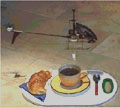 |
 I just finished Pixel II, my second attempt in building micro helicopters. Pixel II is almost 30% lighter than Pixel I and flies
even better. I now reach easily 2 minute flight on 50 mAh batteries. My homepage was updated today with lots of new pictures,
comments and a new lay-out http://www.planetinternet.be/pixel/. You may
want to update your reference to my site with a new picture. I just finished Pixel II, my second attempt in building micro helicopters. Pixel II is almost 30% lighter than Pixel I and flies
even better. I now reach easily 2 minute flight on 50 mAh batteries. My homepage was updated today with lots of new pictures,
comments and a new lay-out http://www.planetinternet.be/pixel/. You may
want to update your reference to my site with a new picture.
Thanks,
Alexander |
Return to "What's In This Issue?"
Skimmer Rating from Matt Dyer - mdyer@gwi.net Augusta,
Maine
 I have seen ratings of various aircraft in Ampeer, so I thought I would submit this
information. I cannot recall having seen a report on the Skimmer, a plane designed by Ted Davey of RCM fame.
I have seen ratings of various aircraft in Ampeer, so I thought I would submit this
information. I cannot recall having seen a report on the Skimmer, a plane designed by Ted Davey of RCM fame.
 My Hobby Lobby Skimmer's statistics are as follows:
My Hobby Lobby Skimmer's statistics are as follows:
Rating *****
Weight (with battery) 44 0z (exactly on spec., usually I build them a tad heavy)
Motor Graupner Speed 500 with 2.8:1 Speed gearbox
Prop Graupner 12X10 folding
Battery 6x1000mAh SCR pack
ESC Astro Model 210
Radio Hitec RX iwth Hitec mini servos
Covering Monokote
Performance - nothing short of excellent. Will Climb to 500 ft. or so three times on one charge with a bit left over
for landing. This plane thermals when there is some good lift around. Very stable in windy conditions. The gear box and prop
make the difference. Model climbs quickly on 2/3's power. The model was originally powered with a Speed 600 and a 8x4.5 inch
Graupner prop and 7 cells. The performance was okay then, but really fantastic now. Easy to build. Takes some abuse without
blowing up (contains battery pack on rough landings without incurring sever internal damage). Simple dihedral wing. Real
bargain price for the kit. Great for beginner or intermediate flyer.
Return to "What's In This Issue?"
SEFLI Fourth Annual Vermont Mountain FLY-INN from Jay Putt -
Jay_Putt@sln.esc.edu
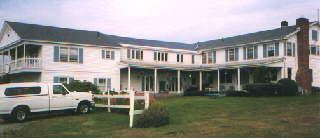
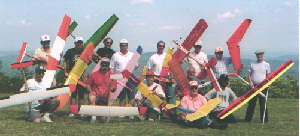
 On August 16th, Tom Hunt CD'd and his brother Pat hosted
the 4th annual Silent Electric Flyers of Long Island Mountain Fly-INN at the Cooper Hill Inn in East Dover, Vermont.
This event has become a annual classic for those die-hard SEFLI-ers who insist on challenging the forces of Vermont's
southern mountain chain with their frail electric craft. The view from the inn is spectacular and Pat and Marilyn Hunt are
wonderful hosts who go out of their way to make you feel at home.
On August 16th, Tom Hunt CD'd and his brother Pat hosted
the 4th annual Silent Electric Flyers of Long Island Mountain Fly-INN at the Cooper Hill Inn in East Dover, Vermont.
This event has become a annual classic for those die-hard SEFLI-ers who insist on challenging the forces of Vermont's
southern mountain chain with their frail electric craft. The view from the inn is spectacular and Pat and Marilyn Hunt are
wonderful hosts who go out of their way to make you feel at home.
 This year was not for the faint of heart as the mountains threw all they could at
us with everything from wicked downdrafts to rocket thermals. Many came but few dared to fly.
This year was not for the faint of heart as the mountains threw all they could at
us with everything from wicked downdrafts to rocket thermals. Many came but few dared to fly.
 For those of you who haven't tried this event, you really should get on Tom's list
for a room at the Inn next year. This year, due to two last minute cancellations, there were a couple of extra rooms available.
But, as nice as the Cooper Hill Inn is, it's not the only game in town for those who still want to come. Tom's brother can
recommend other excellent nearby accommodations if the Inn is full. Since this is a famous fall foliage and winter snow skiing
area, summer is not as busy and there are many nice places nearby to stay.
For those of you who haven't tried this event, you really should get on Tom's list
for a room at the Inn next year. This year, due to two last minute cancellations, there were a couple of extra rooms available.
But, as nice as the Cooper Hill Inn is, it's not the only game in town for those who still want to come. Tom's brother can
recommend other excellent nearby accommodations if the Inn is full. Since this is a famous fall foliage and winter snow skiing
area, summer is not as busy and there are many nice places nearby to stay.
 My wife and I enjoy going to southern Vermont to do other things too and we
always arrive at least a day earlier than most of the others. This year, we went on a horseback trail ride in the mountains the day
before the contest. It was great fun and surprisingly we could still walk after it was over. And I always enjoy searching out rare
old books in some of the small town bookstores.
My wife and I enjoy going to southern Vermont to do other things too and we
always arrive at least a day earlier than most of the others. This year, we went on a horseback trail ride in the mountains the day
before the contest. It was great fun and surprisingly we could still walk after it was over. And I always enjoy searching out rare
old books in some of the small town bookstores.
 For those readers who are interested in the results of the contest, here they are:
For those readers who are interested in the results of the contest, here they are:
Class A Sailplane
Joe Salvator 1011
Tom Hunt 605
Jay Putt 522
Ed Bassick 339
Frank Boch 300
Class B Sailplane
Joe Salvator 756
Tom Hunt 709
Ed Bassick 212
Class A Old-Timer
Frank Boch 696
Jay Putt 646
Tom Hunt 573
 If you are wondering how some of us managed to consistently beat the 1997
Electric NATS Grand National Champion, in all fairness I must report that Tom handicapped himself in a way that he could not
possibly place first in any category. However, the rumor that he had to fly from inside a Vermont cider barrel is not entirely true.
We did allow him a periscope.
If you are wondering how some of us managed to consistently beat the 1997
Electric NATS Grand National Champion, in all fairness I must report that Tom handicapped himself in a way that he could not
possibly place first in any category. However, the rumor that he had to fly from inside a Vermont cider barrel is not entirely true.
We did allow him a periscope.
 Gerhard Spielmann did not compete in the contest but flew a heroic
flight with his Amptique that ended when a monster downdraft slammed it into the mountainside forest. By a miracle of the gods,
it was found in a clearing with just one wingtip slightly damaged.
Gerhard Spielmann did not compete in the contest but flew a heroic
flight with his Amptique that ended when a monster downdraft slammed it into the mountainside forest. By a miracle of the gods,
it was found in a clearing with just one wingtip slightly damaged.
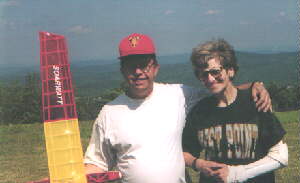 |
 Some demonstration Speed 400 pylon races were flown but it was too rough to
compete with 400 size sailplanes and old-timers. Steve Kowalski (of Kowalski shunt fame) chased Tom Hunt all over the mountainside and gave him
a run for his money. Some demonstration Speed 400 pylon races were flown but it was too rough to
compete with 400 size sailplanes and old-timers. Steve Kowalski (of Kowalski shunt fame) chased Tom Hunt all over the mountainside and gave him
a run for his money.
 If you would like to join us next year, contact Tom Hunt at 516-981-0372, or at
huntth@mail.northgrum.com. It's worth the trip! If you would like to join us next year, contact Tom Hunt at 516-981-0372, or at
huntth@mail.northgrum.com. It's worth the trip!
Photo shows Jay and Gale Putt with his Soarwatt in the mountains of Vermont. Thanks, Jay, for your input in this issue. |
Return to "What's In This Issue?"
MaxCim Now Has a WEBsite & New E-mail Address
 MaxCim Motors site is located at:
http://www.maxcim.com or via snail mail at: MaxCim Motors, Tom Cimato, 57
Hawthorne Dr., Orchard Park, NY 14127-1958 or Phone: (716) 662-5651 or e-mail at:
Maxcim_motors@localnet.com
MaxCim Motors site is located at:
http://www.maxcim.com or via snail mail at: MaxCim Motors, Tom Cimato, 57
Hawthorne Dr., Orchard Park, NY 14127-1958 or Phone: (716) 662-5651 or e-mail at:
Maxcim_motors@localnet.com
 Tom supplies brushless motors and controllers for 7 - 27 cells. The controller has
a 35 Amp continuous, 60 Amp peak rating, which is over 1200 Watts of available power. This is an extremely efficient way to fly
and very versatile system. He is also a supplier of ElectriCalc.
Tom supplies brushless motors and controllers for 7 - 27 cells. The controller has
a 35 Amp continuous, 60 Amp peak rating, which is over 1200 Watts of available power. This is an extremely efficient way to fly
and very versatile system. He is also a supplier of ElectriCalc.
The Future is Brushless
Return to "What's In This Issue?"
Coup and Wasp Plans: Featured in Last Month's Ampeer from Carol Ciarniello -
C.Ciarniello@mbltd.com
 Just a reminder, maybe you can post this info and share it in the Ampeer.
Just a reminder, maybe you can post this info and share it in the Ampeer.
 In addition to providing full size (hardcopy) plans for the W-1 (for those without
printing capability). I also have plans for a 1/6 scale Monocoupe 110 Special and my latest sport flying wing called the -WASP-.
In addition to providing full size (hardcopy) plans for the W-1 (for those without
printing capability). I also have plans for a 1/6 scale Monocoupe 110 Special and my latest sport flying wing called the -WASP-.
 The following photo is the Monocoupe 110 Special. Mine is equipped with an
Astro Cobalt 15 Geared motor and 12 1700-SCRC batteries. Plans are $15 USD (money order, shipping included).
The following photo is the Monocoupe 110 Special. Mine is equipped with an
Astro Cobalt 15 Geared motor and 12 1700-SCRC batteries. Plans are $15 USD (money order, shipping included).
 The following photo is the WASP. It to is powered by the same AF 15 Geared
with 12 1700-SCRC batteries. Again the plans are $15 USD (money order, shipping included).
The following photo is the WASP. It to is powered by the same AF 15 Geared
with 12 1700-SCRC batteries. Again the plans are $15 USD (money order, shipping included).
Plans can be ordered from:
Carlo Ciarniello
C-35 Centennial Drive
RR #1 Powell River, B.C.
Canada, V8A-4Z2
Even More on Carlo's Planes
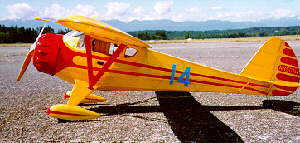

 Elliott J.W. Boulous at "The Institute of Silent Flight" has expressed
interest in making kits of the Monocoupe 110 Special from my plans. I discussed this idea with him over the phone and I am still
waiting for his "legal papers" to make it official. He might even kit the W-1 and the WASP if there is a demand. I
think this is a good thing, as many people hate to scratch build and we certainly need more "electric kits" on the market.
However, I will still make the plans available to those who do like to scratch build.
Elliott J.W. Boulous at "The Institute of Silent Flight" has expressed
interest in making kits of the Monocoupe 110 Special from my plans. I discussed this idea with him over the phone and I am still
waiting for his "legal papers" to make it official. He might even kit the W-1 and the WASP if there is a demand. I
think this is a good thing, as many people hate to scratch build and we certainly need more "electric kits" on the market.
However, I will still make the plans available to those who do like to scratch build.
More good news
 Cesare de Robertis, the editor of MODELLISMO magazine (an RC aero
modelling magazine in Italy) has asked for and received a construction article for my W-1 electric flying wing. I prepared notes,
photos and small sketches to be included in his magazine. I am very excited about this and I will keep you posted if and when it is
published.
Cesare de Robertis, the editor of MODELLISMO magazine (an RC aero
modelling magazine in Italy) has asked for and received a construction article for my W-1 electric flying wing. I prepared notes,
photos and small sketches to be included in his magazine. I am very excited about this and I will keep you posted if and when it is
published.
 Cesare purchased th magazine in 1993 and started it up again after being shut
down in the 1980's. He issues a magazine every 2 months that includes a lot of info on all types of flying and especially electric
RC. In addition he has started to reprint issues from day 1. In fact he has sent me the first 2 reprints which inludes excerpts from
the original magazines 1 through 8 (1943 on). There was even an interview with John Ziac (while he was stationed in Rome during
WW2) brother of Franc Ziac. The reprints are full of info and plans for free flight and CL in Italy at the time.
Cesare purchased th magazine in 1993 and started it up again after being shut
down in the 1980's. He issues a magazine every 2 months that includes a lot of info on all types of flying and especially electric
RC. In addition he has started to reprint issues from day 1. In fact he has sent me the first 2 reprints which inludes excerpts from
the original magazines 1 through 8 (1943 on). There was even an interview with John Ziac (while he was stationed in Rome during
WW2) brother of Franc Ziac. The reprints are full of info and plans for free flight and CL in Italy at the time.
 Of course the magazines are in Italian but if you think people might be interested
(especially in the reprints) I can give you his mail address so people can get a hold of him.
Of course the magazines are in Italian but if you think people might be interested
(especially in the reprints) I can give you his mail address so people can get a hold of him.
 And finally many thanks for mentioning my plans on your internet site and
newsletter.
And finally many thanks for mentioning my plans on your internet site and
newsletter.
Return to "What's In This Issue?"
Plane Ratings from Bill Bowne e-mail at: Sue.Murga@supply.ge.com
 Here are some inputs for your listing of E-power planes and flight characteristics.
I'm leaving out the designs I've done that aren't or won't be commercially available. I've only built two kits in the last three years,
and one of those only lasted one flight (due to a bad hand launch). The other one (Robbe Arcus) is already in your database, so I'll
hold on it.
Here are some inputs for your listing of E-power planes and flight characteristics.
I'm leaving out the designs I've done that aren't or won't be commercially available. I've only built two kits in the last three years,
and one of those only lasted one flight (due to a bad hand launch). The other one (Robbe Arcus) is already in your database, so I'll
hold on it.
NAME: Ol' Dawg
TYPE: High wing monoplane trainer; Rudder/Elevator/Throttle
POWER SYSTEM: Geared 05 (Astro) on 8 * 1000 SCR cells, Astro 205, 10 X 6 prop
AREA: 450 in sq.
WEIGHT: 48 oz (W/L 15.4 oz/ft sq)
SOURCE: My design; plans/kits available from Institute of Silent Flight
COMMENTS: Easy to pop off grass field or hand launch. Very stable and easy to fly with low control throws (I
used it to win the "Chicken" event at 1996 Syracuse E-fly), very aerobatic at high throw. All built up construction.
RATING: 4* - A low-winged version is almost done, and (someday) I'll build a shoulder winged version with
ailerons - One of those may be my 5* model!
NAME: Corvus
TYPE: Higher performance power glider,
Aileron/Rudder/Elevator/Throttle/Flaps
POWER SYSTEM: Astro FAI 25 DD on 10 * 1400 SCR, Astro 205, 9.5 X 6 folder
AREA:
WEIGHT:
SOURCE: My design; plans available from the E-Zone.
COMMENTS: Flies well, not too competitive in All-Up/Last Down as too high a wing loading to be a floater and
too draggy to compete well with glass slippers (although Mickey (my wife) did use it to come in third at 1996 Lehigh Valley E-fly).
Flaps definitely useful in landing. All built up, with very sturdy spruce spar construction. Not too hard to build, but not a
throw-together, either. Sturdy enough to survive several "arrivals" (Mickey's been flying the original Corvus for over
three years, and she sometimes even lets me fly it.). No bad habits, but rolls are sluggish.
RATING: 3 *
NAME: Neutrino
TYPE: Aerobatic model, Aileron/Rudder/Elevator/Throttle
POWER SYSTEM: Astro 035 Direct Drive on 6 * 1000 SCR, Flightec SEC-SP, Graupner 6 X 5 prop.
AREA: 234 in sq.
WEIGHT: 32 oz, W/L 19.7 oz/ft sq.
SOURCE: My design; plans available from the E-Zone.
COMMENTS: Single piece design, motor batteries and aileron servo accessed through belly hatch, rest of radio
and speed controller accessed through canopy hatch. A fast, maneuverable airplane! This model can do more than I can. With
the same power system and a Graupner 6 X 6 prop, the speed is excellent, but the acceleration is not so great, especially when
coming out of a low altitude stall turn. Won't hold altitude well in knife edge, but will do everything else I want - I just have to
learn how to do more! Easy to land. All-built up, with carved blue foam turtle deck and hatch. Very easy to build, but must pay
attention to short aileron linkages.
RATING: 3 *
NAME: Goldie
TYPE: Speed 400 shoulder-winged sport
POWER SYSTEM: 6V speed 400 with 7 * 500 AR or 600 AE, or 7.2V on 8 500 AR or 600 AE, props used:
CAM prop and Robbe 6 X 3.5 folder. Tarling speed control
AREA: 180 in sq.
WEIGHT: 16 oz with 7 cells, 17 oz with 8 (W/L 12.8 to 13.6 oz/ ft sq.)
SOURCE: My design; plans available from Institute of Silent Flight
COMMENTS: Haven't tried more than 8 cells as my Tarling controller is only good for up to 8 (no complaints!).
Easy, fun flier. Looks and flies like a Falcon variant. With control throws turned up, it is very maneuverable. Still, not having a
rudder means all I can do is loop & roll, loop & roll. A full-house version is in the works, though! I like to fly it low &
close, doing lots of loops and rolls until the power is about to go away, at which time I go for altitude and just motor around in big,
lazy circles. The Goldie glides very well and is VERY easy to land. I love making "paint it on" landings right at my
feet, and the Goldie makes them easily. All built up, with a spruce spar. Vertical stab is easy to build, but must be covered with
care as it's also easy to warp.
RATING: 3 * Fun, but no rudder.
Return to "What's In This Issue?"
Electra & Aero-Lectric Ratings from Brad Evenson -
bevenson@sprintmail.com Kirkland, IL
 I have one plane rating that's changed (Electra), and one new one for your list.
Keep up the good work on the site!
I have one plane rating that's changed (Electra), and one new one for your list.
Keep up the good work on the site!
Electra, Goldberg **** Master Airscrew 3.5:1 Flight Pack, MA 12x8 folder, 7x1400 SCR, AF215 ESC. The MA
system made a good plane even better, with longer run time and higher climbouts than the direct drive setup. This was my first
electric and its a joy to fly. It will probably outlast all my other planes!
Midwest Aero-Lectric **** Graupner Speed 600 8.4V, Graupner 9x5 Slim prop, 7x1400 SCR, FX-35D ESC, 2
FMAS200 servos, BEC. A fine flier, great for just "tooling around". I get about 9 minutes of mixed flying on the above
setup. Plan to reinforce the fuselage bottom with some fiberglass cloth if you intend to leave the landing gear off like I did. Kit was
very easy to build and plenty of room inside for gear.
Return to "What's In This Issue?"
The October EFO Meeting
 The meeting was held in Ken's room at Dublin Elementary. Jack Lemon and Richard Utkan shared their photos from
KRC. Ken learned that his X440 went to KRC and flew without him! Ken and Richard did the plane as a combined project,
since Richard had the radio and power system. They've both enjoyed flying it at the August and September flying meetings. It is
a superior flier. Highly recommended for fun floating. (Photo of Richard and X440 at KRC is left below.)
The meeting was held in Ken's room at Dublin Elementary. Jack Lemon and Richard Utkan shared their photos from
KRC. Ken learned that his X440 went to KRC and flew without him! Ken and Richard did the plane as a combined project,
since Richard had the radio and power system. They've both enjoyed flying it at the August and September flying meetings. It is
a superior flier. Highly recommended for fun floating. (Photo of Richard and X440 at KRC is left below.)
 Ken showed his new Jomar "Micromax" Speed 400 throttle. Richard shared his Modelair-Tech H-100
gearbox. Don Skiff showed off is S400 powered, glow conversion, InBetween. He says that it flies very well! Lots of interest in
this one. (See the right photo below.)
Ken showed his new Jomar "Micromax" Speed 400 throttle. Richard shared his Modelair-Tech H-100
gearbox. Don Skiff showed off is S400 powered, glow conversion, InBetween. He says that it flies very well! Lots of interest in
this one. (See the right photo below.)
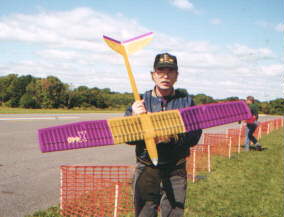 | 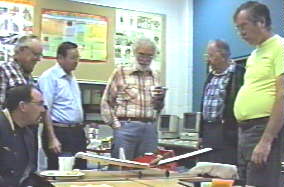 | |
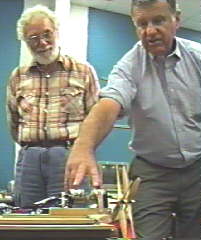 |
 Corky Boyd showed up with a really unique S400 inline twin. It turns counter rotating 4 bladed props. This piece of
engineering just has to be seen to be believed. The motors are wired in parallel. As Ken was holding the test board, he can tell
you it really threw back the wind, yet was only drawing about 10 amps per motor. Neat. Corky Boyd showed up with a really unique S400 inline twin. It turns counter rotating 4 bladed props. This piece of
engineering just has to be seen to be believed. The motors are wired in parallel. As Ken was holding the test board, he can tell
you it really threw back the wind, yet was only drawing about 10 amps per motor. Neat. |
 Jack also had a picture of Keith's finished Bearkitty, the Astro Flight 020 brushless version of a Bearcat. Here's Jack's
photo, along with a "before" photo from Ken.
Jack also had a picture of Keith's finished Bearkitty, the Astro Flight 020 brushless version of a Bearcat. Here's Jack's
photo, along with a "before" photo from Ken.
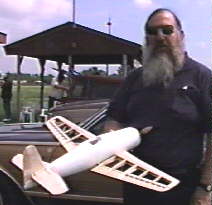 | 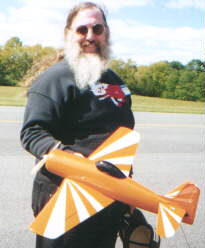 |
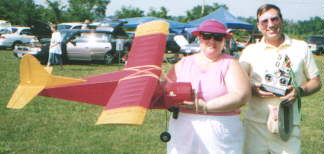 |
 Jack also provided the photo
of Debbie McNeely, Ken and her AF15G powered Beaver. The photo was taken at the '97 Mid-Am. Jack also provided the photo
of Debbie McNeely, Ken and her AF15G powered Beaver. The photo was taken at the '97 Mid-Am. |
 Clay Howe's video of the '97 Mid-Am was also shown at this meeting. If you've not ordered your copy yet, it is highly
recommended that you do so.
Clay Howe's video of the '97 Mid-Am was also shown at this meeting. If you've not ordered your copy yet, it is highly
recommended that you do so.
 The refreshements were enjoyed by all. Ya all stop by the meeting for a good
time and some good friends.
The refreshements were enjoyed by all. Ya all stop by the meeting for a good
time and some good friends.
Supplier Addresses for Products Mentioned at the Meeting:
EMS/Jomar, 22605 La Palma Ave., Suite 518, Yorba Linda, CA 92887 --- Phone: (714) 692-1393 Fax: (714) 692-1330
Astro Flight, Inc., 13311 Beach Ave., Marina Del Rey, CA 90292 --- Phone: (310) 821-6242 http://www.astroflight.com/
ModelAir-Tech, P.O. Box 1467, Lake Grove, N.Y. 11755-0898, Phone/FAX: 516-981-0372 e-mail - http://www.modelairtech.com/
SR Batteries, Box 287, Bellport, NY 11712 Phone: (516) 286-0079 or e-mail to Larry at :74167.751@compuserve.com
Home of the fantastic X440 Speed 400 sailplane! Visit http://www.hangtimes.com/vendor1.htm
CHVideo Videos available are:
- '94 KRC - 1 hour 47 minutes - VHS SP
- '95 KRC/Mid America - 1 hour 50 minutes - VHS SP
- '96 Mid America - 1 hour 37 minutes - VHS SP
- '96 AMA/NEAC Electric NATS - 2 hours 25 minutes - VHS SP - T-160
- '97 Mid-America - It's 1 hour and 53 minutes of good stuff, and includes awards to a couple of the top electric gurus as well as
Keith Shaw's Bearcat and Dave Grife's Elextra, and much, much more.
Current prices are as follows:
1 video - $20; 2 videos - $37; 3 videos -$51; 4 videos - $63; all 5 videos for $73
...the prices above include shipping to addresses in the US and Canada, including APO and FPO.
Videos may be ordered by sending a check or money order to:
CHVideo, 310 S Jefferson St , Sturgis, MI 49091
NOTE: Make check or money order payable to: Clay Howe
For more information, e-mail: clayhowe@net-link.net
Return to "What's In This Issue?"
Flying Models
 Bob Aberle was kind enough to send along info for the address to Flying Models,
as was discussed in the October '97 Ampeer. Here is what he sent: Flying Models, Carstens Publications, P.O. Box 700, Newton,
NJ 07860 - Phone: (973) 383-3355, FAX: (973) 383-4064, Reader and Plans Service: Lynn Thomas - found in book stores &
hobby shops.
Bob Aberle was kind enough to send along info for the address to Flying Models,
as was discussed in the October '97 Ampeer. Here is what he sent: Flying Models, Carstens Publications, P.O. Box 700, Newton,
NJ 07860 - Phone: (973) 383-3355, FAX: (973) 383-4064, Reader and Plans Service: Lynn Thomas - found in book stores &
hobby shops.
 I did add a bit to it. I should put in information that is known to me, like that above,
but it sometimes slips my mind. I thank Bob for keeping on task!
I did add a bit to it. I should put in information that is known to me, like that above,
but it sometimes slips my mind. I thank Bob for keeping on task!
Return to "What's In This Issue?"
EAA Calendar TIME!
 Here's a great present for yourself or any friend who likes aircraft. The 1998
EAA calendar is now available. If you want one of the best Aviation calendars around, you can't beat the 1998 EAA Calendar!
Fantastic pictures and day by day important aviation dates! Also available is the 1-hour video of Oshkosh '96. Calendar
$10.95 + 4.00 shipping and video is $10.00 (a $19.95 value!) with the purchase of the calendar with FREE shipping on the video.
For fastest service call Sharon Ramey & Associates (616) 347-8851; or Sharon Ramey & Associates, P.O. Box 2045, Petoskey,
MI 49770
Here's a great present for yourself or any friend who likes aircraft. The 1998
EAA calendar is now available. If you want one of the best Aviation calendars around, you can't beat the 1998 EAA Calendar!
Fantastic pictures and day by day important aviation dates! Also available is the 1-hour video of Oshkosh '96. Calendar
$10.95 + 4.00 shipping and video is $10.00 (a $19.95 value!) with the purchase of the calendar with FREE shipping on the video.
For fastest service call Sharon Ramey & Associates (616) 347-8851; or Sharon Ramey & Associates, P.O. Box 2045, Petoskey,
MI 49770
Return to "What's In This Issue?"
Upcoming Events:
December 6, EFO get together, at the McNeely's (see map)
February 13, 14, 15, 1998 - THE SAN DIEGO WINTER ELECTRICS -- Equipment manufacturers and
vendors are invited to display their latest achievements. For details, e-address- info@sefsd.net
Return to "What's In This Issue?"
Next Meeting: Thursday, December 6, 1997, McNeely Residence, 4733 Crows Nest Ct., Brighton Twp. (810) 220-2297
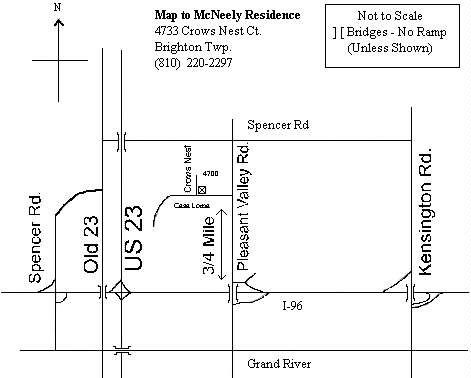
To Reach Ken Myers, you can land mail to the address at the top of the page. My E-mail address
is:
KMyersEFO@aol.com EFO WEBsite: http://members.aol.com/KMyersEFO/
Return to "What's In This Issue?"

 Thanks for the notice about the Ampeer and the update on your flying activities.
I have been doing a fair amount of experimenting (and unfortunately, crashing) myself. I modified an E-streak to accomodate my
geared Astro 05 internally (using a Kavan motor mount) and gave it a very clean nose with a faired-in spinner. I also built a
different wing - a straight-chord 54 inch wing (57 inch with the foam wing tips) using an Eppler 193 airfoil. I set it up with 9
1700-mah cells, an APC 10-10 prop, New Creations 40 amp BEC ESC, Airtronics micro-receiver, and four TS-11
micro-servos (two for ailerons). The total weight came out to be 47 oz, drew 31.5 amps static while turning 8100 rpm. What a
hot rod! Incredible climb, high speeds, and all the aerobatics you could want (or at least, that I could do!). It was even an
excellent glider. I was going to demo it at Pat Mattes' e-meet this past Saturday. Unfortunately, a repaired wing dowel (lesson
learned - replace, don't repair, wing dowels!) apparently broke in flight, allowing the rubber bands to come off the wing - and yes,
the wing came off the plane about 300 feet up going full throttle. It made a great missile, but
eventually it impacted the ground, breaking a motor magnet, wiping out my ESC, and stripping one of the micro-servos.
Thanks for the notice about the Ampeer and the update on your flying activities.
I have been doing a fair amount of experimenting (and unfortunately, crashing) myself. I modified an E-streak to accomodate my
geared Astro 05 internally (using a Kavan motor mount) and gave it a very clean nose with a faired-in spinner. I also built a
different wing - a straight-chord 54 inch wing (57 inch with the foam wing tips) using an Eppler 193 airfoil. I set it up with 9
1700-mah cells, an APC 10-10 prop, New Creations 40 amp BEC ESC, Airtronics micro-receiver, and four TS-11
micro-servos (two for ailerons). The total weight came out to be 47 oz, drew 31.5 amps static while turning 8100 rpm. What a
hot rod! Incredible climb, high speeds, and all the aerobatics you could want (or at least, that I could do!). It was even an
excellent glider. I was going to demo it at Pat Mattes' e-meet this past Saturday. Unfortunately, a repaired wing dowel (lesson
learned - replace, don't repair, wing dowels!) apparently broke in flight, allowing the rubber bands to come off the wing - and yes,
the wing came off the plane about 300 feet up going full throttle. It made a great missile, but
eventually it impacted the ground, breaking a motor magnet, wiping out my ESC, and stripping one of the micro-servos.












